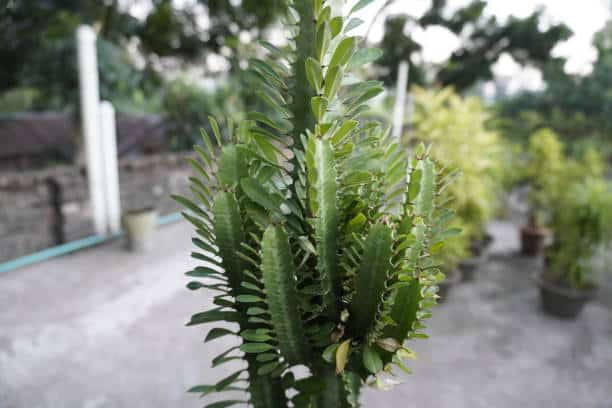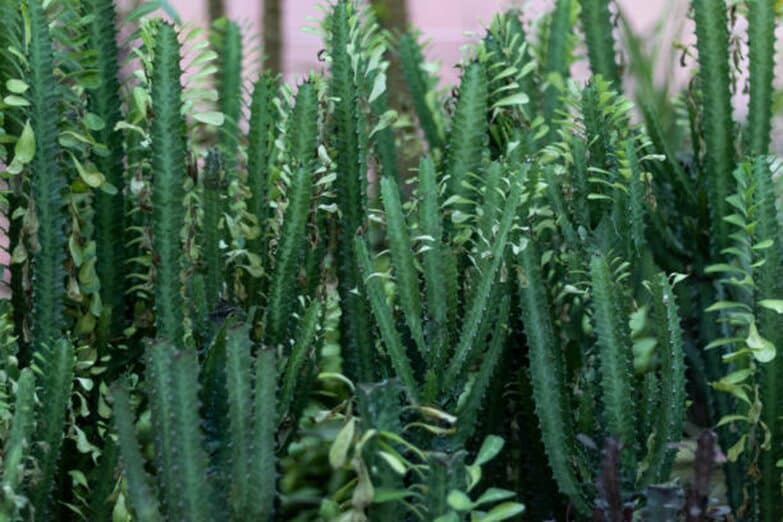Euphorbia trigona, also known as the African milk tree or cathedral cactus, is a unique succulent native to West Africa. Its striking appearance, low maintenance needs, and easy propagation make it an excellent choice for both novice and experienced plant enthusiasts. This comprehensive guide will provide you with all the information you need to successfully grow and care for your Euphorbia trigona.
Understanding Euphorbia Trigona: Appearance and Characteristics
Growth Habit and Structure
Euphorbia trigona is characterized by its tall, columnar growth habit, which can reach up to 6-8 feet in height indoors. It features a thick, fleshy stem with prominent ribs running vertically, giving it a cactus-like appearance. The stem is covered with small, sharp spines arranged in pairs along the ribs.
Foliage and Flowers
The African milk tree produces small, oval-shaped leaves that grow directly from the stem, close to the spine pairs. The leaves are typically green or dark green, but they may develop a reddish tinge when exposed to bright sunlight. Euphorbia trigona rarely flowers indoors, but when it does, it produces inconspicuous, greenish-yellow flowers near the stem tips.
Euphorbia Trigona Care Requirements
Light and Temperature
Euphorbia trigona thrives in bright, indirect sunlight. A south or west-facing window is ideal, as it will provide the plant with ample light throughout the day. However, avoid placing it in direct sunlight, as this can cause sunburn and damage the leaves.
This succulent prefers temperatures between 65°F and 75°F (18°C and 24°C) during the day and slightly cooler temperatures at night. Avoid exposing it to temperatures below 50°F (10°C), as this can cause leaf drop and other issues.
Watering and Humidity
As a succulent, Euphorbia trigona is drought-tolerant and requires minimal watering. Water the plant thoroughly, allowing the excess water to drain away, then wait until the top 1-2 inches of soil are dry before watering again. Overwatering can lead to root rot and other problems, so it’s essential to err on the side of caution.
Humidity is generally not a concern for Euphorbia trigona, as it is adapted to arid environments. However, maintaining average indoor humidity levels should be sufficient to keep the plant healthy.
Soil and Fertilizer
Euphorbia trigona requires well-draining soil to prevent root rot. A cactus or succulent potting mix is ideal, as it will provide the necessary drainage and aeration. Alternatively, you can create your own mix by combining equal parts of potting soil, perlite, and coarse sand.
Fertilize the African milk tree with a diluted cactus or succulent fertilizer during the growing season, typically from spring through summer. Feed the plant once every 4-6 weeks, following the package instructions for proper dilution and application.
Propagation and Repotting

Propagating Euphorbia Trigona
Euphorbia trigona can be easily propagated through stem cuttings. To do this, carefully cut a healthy stem section, ideally 4-6 inches long, using a sharp, clean knife. Allow the cutting to dry and callous over for a few days before placing it in a well-draining potting mix. Water sparingly until the cutting establishes roots and begins to grow.
Repotting Euphorbia Trigona
The African milk tree is a slow-growing succulent, so it doesn’t require frequent repotting. Generally, you should repot every 2-3 years, or when the plant becomes root-bound. When repotting, choose a container that is one size larger than the current one, with sufficient drainage holes. Be sure to handle the plant with care, as its sap can cause skin irritation.
Potential Issues and How to Address Them
Pest and Disease Issues
Euphorbia trigona is relatively resistant to pests and diseases. However, it can occasionally be attacked by common houseplant pests like mealybugs and spider mites. If infested, you can treat the plant using a mild insecticidal soap or neem oil.
Overwatering can lead to root rot, a common issue for many succulents. If you notice the leaves becoming yellow or mushy, check the roots for any signs of rot. If detected, remove the affected roots, let the plant dry out, and repot it in fresh, well-draining soil.
Handling Precautions
One crucial aspect to be aware of when handling Euphorbia trigona is its sap. This plant’s sap is milky and can cause skin and eye irritation on contact. Always wear gloves when handling, propagating, or repotting this plant, and avoid touching your face or eyes.
Conclusion
Euphorbia trigona, with its striking appearance and low-maintenance care requirements, is a fantastic addition to any indoor plant collection. With the right care – ample light, well-draining soil, and careful watering – you can enjoy the beauty of this resilient and attractive succulent for years to come. Whether you’re a seasoned plant enthusiast or a beginner, the African milk tree is sure to bring a touch of exotic allure to your home or office.

